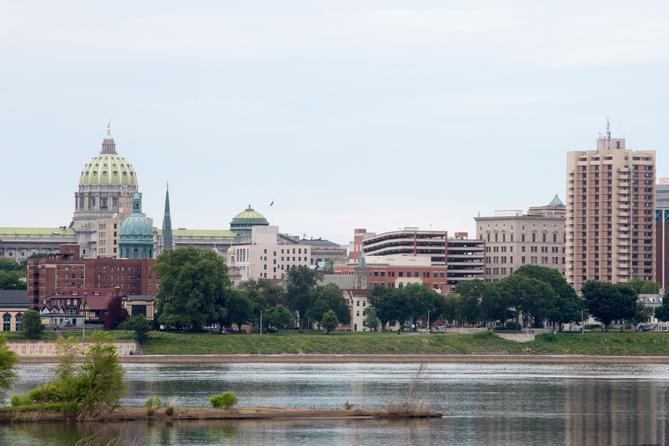Spotlight PA is an independent, nonpartisan newsroom powered by The Philadelphia Inquirer in partnership with the Pittsburgh Post-Gazette and PennLive/Patriot-News. Sign up for our free weekly newsletter.
Update, May 28: Lawmakers on Thursday approved the use of $2.6 billion in discretionary federal stimulus dollars for a variety of purposes including providing relief to counties and hard-hit long-term care facilities. Read more.
HARRISBURG — After enduring more than two months of the coronavirus pandemic, and with state revenues continuing to tank, Pennsylvania has yet to spend a dime of $3.9 billion in discretionary federal stimulus dollars intended to aid in the relief effort.
The pot of money is by far the largest available to the state, and the most valuable. And while it currently cannot be used to make up for lost revenues — projected to be as much as $5 billion by next June — there is hope in some corners the rules could change.
The second unknown is whether Congress and President Donald Trump will agree on another stimulus package that would provide direct cash assistance to state budgets, which might change how Pennsylvania chooses to spend the current round of cash.
These unknowns could make it advantageous for state officials to take their time allocating the money, but some Democratic lawmakers are agitating to move faster. That includes Sen. Vincent Hughes (D., Phila.), who wants to use $550 million for small business grants.
“Money has been sitting in Pennsylvania’s account for six weeks,” he said in a statement. “The question is: Why are we waiting?”
The funding was provided through the Coronavirus Aid, Relief, and Economic Security (CARES) Act, a $2 trillion package hastily written by Congress with money for small businesses, recently unemployed workers, and industries impacted by the pandemic.
The act created a $150 billion Coronavirus Relief Fund for states and localities “to address unforeseen financial needs and risks created by the COVID-19 public health emergency,” according to the U.S. Treasury. Of that, $4.9 billion was earmarked for Pennsylvania, with $1 billion going directly to the state’s seven largest counties.
Gov. Tom Wolf has the authority to decide how the remaining $3.9 billion is spent, but he has pledged to work with the legislature, and there has been movement.
The state House and Senate are advancing separate versions of legislation to tap the money for the first time, largely to provide millions of dollars in relief to hard-hit nursing homes and other long-term-care facilities across the state.
As of Wednesday, nearly 15,000 nursing home residents have become ill with the virus, and more than 3,000 have died. State officials have announced plans to increase testing at these nursing homes, but some facilities have balked, saying they need more cash assistance.
The Senate bill would appropriate $538 million to industries and workers on the front lines, with the largest chunk — $507 million — going to long-term care facilities through the Department of Human Services. Fire companies would also receive $26 million in funds, and first responders would receive $4 million.
The measure only specifies the funds must be used for coronavirus-related expenses, though it has no language requiring the Department of Human Services or recipients to report how it was spent.
A House version, developed by Speaker Mike Turzai (R., Allegheny) in consultation with UPMC and health-care experts in Pittsburgh, would spend $500 million to create regional health collaboratives and put academic medical centers in charge of assisting long-term-care facilities.
Funding would be allocated to each institution based on its proposal, which would outline how supplies, staffing, testing, and protective equipment would be given to nursing homes that need help, with a focus on increased testing and infection control.
The Department of Human Services would be tasked with implementing the plan. Turzai’s bill includes an additional $767 million in CARES dollars for the department to hand out to long-term-care facilities and other providers, bringing the total price tag to $1.3 billion.
Turzai said academic medical institutions are the only entities with the expertise to step in.
“They should have been consulting with these experts right from the beginning,” he said of the state. Now, “the legislature has to take the lead, and we are.”
The only lawmaker to oppose the House bill, Rep. Pam DeLissio (D., Phila.), said on the floor last week the legislation does not provide enough accountability for how the funds can be spent — like capping how much can be used for administrative salaries.
“With this kind of significant, meaningful, substantive resource, I would like to see those resources applied in the most effective way possible,” she said. “Unfortunately, I will be a ‘no’ vote. And if anybody doubts my passion for this sector, they would be grossly mistaken.”
Mike Straub, a spokesperson for House Republicans, said he disagrees with the notion that the bill is weak on accountability.
“The [Department of] Human Services would collect proposals from the collaboratives for how to best effectively support COVID-19 readiness and response in facilities, improve quality of care, and expand testing for staff and residents in long-term-care facilities,” Straub said. “Collaboratives are also required to perform daily reviews of facilities.”
In a report last week, the U.S. Department of the Interior warned that “accurate and timely review of performance and financial reports” will be vital to providing oversight of CARES Act money.
“Awards made as part of emergency response are riskier than normal because they are awarded quickly and often without competition, and have a higher purchase threshold than other acquisitions,” agency officials wrote.
Lyndsay Kensinger, a spokesperson for Wolf, said the governor supports the Senate’s bill in its current form, but not the House legislation.
What Wolf and the legislature will do with the other discretionary money remains to be seen. The General Assembly this week is expected to pass a short-term budget that flat-funds the government and its services for the next five months. House Republicans say this will buy time to get a clearer picture of the strain placed on Pennsylvania’s finances by the state’s efforts to slow the spread of COVID-19.
It could also provide time for more clarity on how the stimulus money can be spent, and what more might be coming from the federal government.
At the moment, the U.S. Treasury says none of the discretionary CARES dollars can replace state or local tax revenues that have been lost due to the pandemic, though funds can be used to pay for workers who are “substantially dedicated” to responding to the coronavirus.
Some federal lawmakers, including members of Pennsylvania’s Republican House delegation, are pushing to allow the money to be spent on lost revenue.
In the meantime, state Senate Democrats have ramped up pressure to start spending the discretionary dollars. Previously, the caucus released a list of priorities for appropriating the CARES Act funding, with most of the money earmarked for housing assistance, student debt relief, veterans’ assistance, and schools.
Separate from the discretionary money, state agencies have also been awarded $2.5 billion in federal dollars earmarked for specific purposes, according to a breakdown provided by the Wolf administration.
The Department of Health, the agency at the center of the state’s response, has received $72.8 million for several purposes including epidemiology and laboratory surveillance and response. The Department of Education received $523.8 million to provide relief to schools, while the Department of State received $14 million to cushion costs related to the 2020 election.
Thus far, $653.6 million has been appropriated or committed by state agencies or offices.
All told, the federal government has injected $78 billion into the state’s economy in response to the coronavirus pandemic, according to a report by the Independent Fiscal Office. That number includes forgivable loans provided to small businesses through the Paycheck Protection Program and the $1,200 stimulus checks sent directly to residents.
Rebecca Moss of Spotlight PA contributed to this article.
100% ESSENTIAL: Spotlight PA relies on funding from foundations and readers like you who are committed to accountability journalism that gets results. If you value this reporting, please give a gift today at spotlightpa.org/donate.

